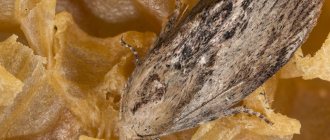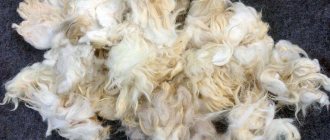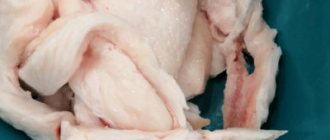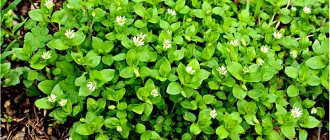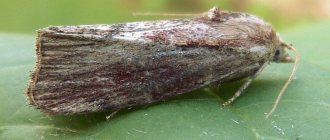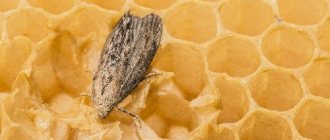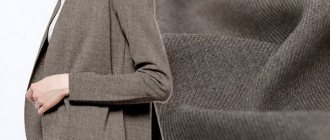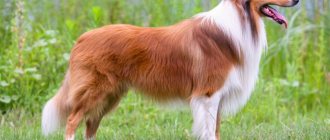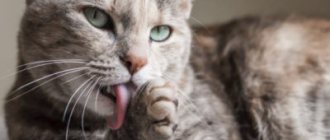How to make yarn from dog or cat hair with your own hands
During the cold season, we like to wrap ourselves in soft and warm blankets, sweaters, shawls, muffs, and buy hats and mittens made of sheep or cashmere thread. But yarn made from dog hair is much warmer and can be obtained for free if you are not lazy in combing, processing the finished raw materials and knitting. We are ready to buy warm clothes at the market or in a store. But we completely overlook the fact that we have dogs and cats, after which we simply throw away a large amount of fluff and wool. Having such a fluffy dog at home, every day we comb out the excess fur, which we then take to the trash. But the quality of this natural fiber is in no way inferior to wool obtained from a sheep, rabbit or camel.
Products made from dog hair: therapeutic effects, contraindications
First of all, the question arises: why from a dog? Who cares?
Dog fur has a greater ability to retain heat than any other, and in addition, it neutralizes electrification on the surface of the skin. It is not for nothing that among the peoples of the North, winter boots or high boots are sewn with dog fur.
The hairs on a dog's coat are thicker and stiffer, which provides a massage effect. It causes intense blood flow to sore spots and improves overall blood circulation.
But despite all the advantages, even such a harmless treatment has contraindications; it cannot be used anywhere where heating is prohibited: pain in the pancreas and appendix, open wounds and skin diseases. Before heating, you need to know the cause of the pain.
Special belts for the treatment of joints, mittens, socks, knee pads and vests are an incomplete list of everything that can be made from dog hair. The production of these things has already been put into production and is in great demand. But their price differs significantly from the cost of other woolen products. Therefore, instructions and master classes on this topic will be useful for beginning craftsmen.
What products are made from cat hair?
Cat fur is used in different ways: for knitting and for dry or wet felting. The fur of cats is relatively short and smooth, so for a beginner the whole process of making products from it will not be easy.
In order, as they say, to get better at it, it is, of course, better to first practice on dog hair. However, even without such experience, processing cat hair and making products from it is quite possible. The only thing you need to stock up on is patience.
And they knit anything from cats’ wool:
- medical belts;
- socks;
- mittens;
- hats;
- vests;
- sweaters.
Electric spinning wheels spin well and quickly
The invention of the electric spinning wheel has several advantages. This is compactness and speed. Experts say that working on it requires virtually no skills. The principle of forming a thread from wool is the same for spinning wheels - the strand is pulled out of the tow, twisted and wound into a ball.
Then the finished yarn must be twisted. If the spinning wheel does not have such a function, then you can twist it manually on a spindle.
The photo shows what this device looks like. We spin dog hair on an electric spinning wheel in the same way as in other cases - separating small pieces of combed wool and twisting them.
Indications
A wool back belt is recommended for wearing by people engaged in heavy physical labor (loaders, production workers, athletes, etc.), often exposed to the cold, and people with a sedentary lifestyle (drivers, office employees).
Under these conditions, the belt will protect against possible back injuries (hernia, protrusion, pinching and inflammation of the nerve roots), and will also protect the internal organs from hypothermia and inflammation.
Doctors have identified a list of diseases for which the wool bandage has proven most effective:
- radiculitis;
- neuritis;
- osteochondrosis;
- rheumatism;
- prostate diseases;
- infectious and viral diseases;
- bronchitis, pneumonia and other ailments of the respiratory system;
- urolithiasis disease;
- pinched nerves;
- inflammation of the genitourinary system;
- hernias, protrusion of the spine;
- injuries and pain in the spine;
- back muscle spasm.
The therapeutic effect of such a belt is much higher than that of the well-known mustard plasters and cupping. For colds and coughs, this accessory is indispensable.
Wet felting
First, we take a piece of film with a margin of approximately 15 cm on each side of the expected belt size. This is necessary so that you can tuck the edges of the dog hair “layer cake” (this will create a smoother rectangular shape, and you will not need to cut off precious pieces of the felt mat).
Now we take the dog’s hair itself and begin to “ruffle” it. We will do this with our hands, but carefully. How to do it? Rinse and gut a small ball of dog hair until fine and fluffy.
With such scraps we lay out the entire first layer of the workpiece in one direction. We put our disheveled scraps so that they overlap one another. This way we avoid bald spots and voids in the rug.
The next step is to apply a second layer, but in the opposite direction. We do not allow omissions and do not forget about overlaps. So we lay at least 4 layers. If it is possible and there is a lot of raw material available, more layers are possible.
The felt will be denser and stronger. The result was a fluffy “layer cake” of scraps of dog hair stacked one on top of the other.
Now we need to thoroughly moisten all this with hot soapy water. Why hot? Hot water straightens the hairs, and the soap solution helps them adhere to each other into a dense mass.
Attention
This is the most crucial moment. Wetting from a spray bottle is not quick, but it is reliable. Pieces of wool will not move anywhere, voids or lumps will not form. But you need to take into account that dog hair doesn’t get wet well, so you can water it by hand, trying not to knock a single piece out of its place.
When everything is properly wet and the workpiece has become twice as thin as our fluffy original rug, you can pour a bolder soap solution. But not in a stream or stream. Its density and durability will depend on how well our entire future belt made of dog hair gets wet.
In our case, the mesh allowed soapy water to spill through the top. On the one hand, this is good and convenient, on the other hand, bubble wrap, although it prevents the wool from getting wet, makes it possible to felt the wool very tightly
You have to remove the top film and very carefully wet the unprotected mat
Tuck the edges of the bottom film inward (we had a rather stiff mesh, so there were problems with tucking). Now you can cover the wet and settled mat with a second film or mesh
Carefully but very tightly roll the resulting film pancake onto a rolling pin (it is most convenient for our purpose)
To prevent this whole structure from unwinding and falling apart during the process of felting wool, we will secure our “sausage” with a rope in a spiral or with hair elastic bands along the entire length. We will hit and roll this whole thing, so we need reliable fixation.
Since we are making a dog hair belt with our own hands, we cannot allow valuable raw materials to go to waste. We tie it tightly, without tightening it, so that the whole structure can be pounded without fear and, at the same time, without tearing the wet felt. We want to end up with a belt that is tight, durable and free of torn holes.
Well, now it’s time for the mechanical part of the work. We take a rolling pin with a workpiece wound around it and begin to squeeze it with our hands, roll it and tap it on all sides on the table or, as in our case, on a bed of wooden balls. If it’s not there, it doesn’t matter - on a flat surface, preferably wooden, it turns out no worse. So we roll and knock for 15-20 minutes.
Attention
We tap on all sides more than we roll. This way there is less risk of deforming the workpiece.
Then we carefully unwind and see what we got. If bald spots appear or something has moved, we fix it. Place scraps of wool on the voids and moisten them generously with more soapy water.
We wrap the bottom film together with the edges of the wet workpiece to make a product of the correct shape, again lay the film on top and roll everything back onto the rolling pin. We knead, tap and roll for another 20 minutes, or even half an hour.
The density of the felt, and, consequently, the quality of the future dog hair belt, which we are now making with our own hands, will depend on how long and how diligently you subject the workpiece to mechanical stress.
Now you can rinse the “sausage” under running water. We do this without unwinding or unfolding the workpiece.
Next, you need to untie everything, lay out the resulting felt mat on a flat surface, remove the top film and wash it again with soapy water.
If you did everything as it should, the resulting thick felt mat can even be carefully rinsed
Making Handmade Yarn (Dog Hair + Sheep Wool)
In ancient times, homemade creativity was popular in villages: weaving, spinning, knitting, embroidery. Previously, there were no clothing stores, so women created them at home. Today, among the variety of factory goods, the technology of spinning threads has not died out, but, on the contrary, has been modernized and acquired its own special status. I want to tell you about how wool threads are created from a bag of dog hair in an ordinary city apartment. Why from a dog? - you ask - because it is dog hair that perfectly retains heat; contains surfactants, the penetration of which through the skin has a beneficial effect on the body and reduces pain; having a micromassage effect, improves blood circulation; speeds up the healing process and much more.
One of the items in our store is handmade yarn. When visiting various fairs and handmade goods stores, you involuntarily catch yourself thinking “where does such a range of prices come from?” After all, when we come to any store or supermarket for consumer goods, we encounter approximately identical prices. But handmade works, as it is now fashionable to call them DIY, always have a high pricing policy. The price primarily reflects the quality. Time spent on the creative part - coming up with ideas, and the physical part - the work itself. The soul that a person puts, a piece of himself, when fulfilling an order.
I knit all my products from 100% natural wool yarn. Yarn composition: 80% dog hair (Siberian Husky or Malamute) + 80% sheep wool. Dog hair has healing properties and incredible warmth. But, yarn can only be made from combed wool, or rather the undercoat, which is quite short. Therefore, for the readability and durability of my products, I add sheep wool to the yarn, because... Sheep wool fibers are denser and more tenacious. The coat of Siberian Huskies is odorless (if the dog is properly cared for) and clean, so it does not require special preparation. But putting the wool of a sheep in order is a whole story. I will show you exactly the stages of preparing sheep wool: 1) We have such a pile of sheared sheep wool.
2) First, the wool must be washed well. We soak our wool in a basin, fill it with warm water and leave it to soak for a couple of hours. Then we carefully wash it by hand to get rid of any remaining fat from the sheep’s skin, dirt, foreign odors, etc.
Preliminary work
Before you start making yarn, you need to do some preliminary work. To do this, we will need to perform several steps.
- Find a source for obtaining the material: your own dog or friends who have one and are ready to share.
- Collect the required amount of material.
- Clean it up.
- Prepare all the necessary tools and think about the plan.
Assembly
If you have found a method for obtaining it, you must collect the yarn correctly. After brushing your dog, collect hair from the brush. Mechanically remove coarse hairs and dirt. Place the lump in a fabric bag (The structure of tissues of living organisms is studied by the science of histology)
or a cardboard box.
IMPORTANT! It is better to avoid storing in plastic bags and take care to ensure good air circulation in the bag.
Wash
After collection, you need to properly wash the workpiece. To do this, place a soap solution in a basin or bowl. Immerse the product in it, gently press with your hand and let it soak . After this, take clean water and get rid of the remaining soap until the clean water begins to run out.
IMPORTANT! All actions should be done carefully and without sharp twisting to avoid breaking the fibers.
Drying wool
Drying is the final preparation step. There is no need to artificially create conditions to speed up the process.
The best source of warm air is sunlight. The circulation of fresh air is also important. If possible, just take the workpiece outside and spread it moderately on newspaper.
What products are knitted from cat hair and what are their benefits?
There are many reasons why wearing products made from cat hair is beneficial. First of all, these products are very warm and, for example, socks will not allow your feet to freeze even in the most severe frost. In addition, they will be much softer than socks made from dog hair and very pleasant when in contact with the skin.
Any type of wool has active properties, thanks to which products made from it have a healing effect. But this does not mean at all that this or that disease can be treated with clothes knitted from cat fur. The course of treatment is prescribed by the doctor, and knitted items will only speed up the healing process.
Although products made from cat hair are much softer than those made from dog hair, the tingling effect is still present in this case. This is a kind of massage, thanks to which blood flows more actively to the sore spot. Products made from cat hair will help with:
- rheumatism;
- diseases of the upper respiratory tract;
- radiculitis;
- chronic runny nose;
- bronchitis;
- gynecological problems;
- consequences of pneumonia;
- headaches;
- otitis media
It is also useful to wear a belt made of cat hair when there is aching pain in the place where the bone was broken. Cat fur allows the skin to breathe, warms it and massages it. The only restriction for wearing products made from cat hair is an allergy to it.
Healing characteristics
Naturally, it is not difficult to collect a bag of wool from your own pet, and the main problem lies in spinning the thread. But if you find a skilled spinner or learn to spin yourself, you will get a virtually inexhaustible source of not only warm, but also healing wool.
As a rule, children are susceptible to colds, and a scarf made of such healing fiber will help avoid a sore throat or alleviate it. The real scourge of our time has become pain (physical or emotional suffering, painful or unpleasant sensation)
in the joints, which affects not only old people. And here elements of clothing made from dog hair come to the rescue: belts, knee pads, bandages.
Often they choose products made from coarse wool, which “bites”, so how exactly does it immediately produce the effects of acupuncture, micro massage and provoke nerves (related to bundles of nerves)
endings, which is very important for certain acquired ailments.
And if you add to the above qualities the energy of your beloved dog or cat, who loves you very much, makes you happy, lives for you, then we get a truly magical ball of threads, destined to become your amulet.
How to prepare wool for spinning at home
Wool requires meticulous preliminary preparation before spinning. First you need to sort it out, completely removing everything extraneous. Then the fur is carefully combed. It is more convenient to do this procedure using special combs. You should put a little raw material on one of them, combing it with the other until there is no material left on the first one.
Cleaning and washing
Before spinning, you need to sort through the fibers, clean them of debris, comb and wash them well, and then dry them. Although it is easier to spin unwashed wool, it has a specific odor and can be very dirty. To eliminate the aroma, it is recommended to fill the wool with slightly warmed water, periodically changing the liquid for a couple of days.
The material must be washed in mesh bags. If they are not there, it is quite acceptable to use curtain fabric or unusable tights. When the wool is dirty, it needs to be washed in several waters. First, draw in hot liquid to reliably remove grease along with adhering sand and dirt. Any product designed for washing woolen products will help you cope with the task. After the first procedure, the material must be rinsed well. When all stages of washing are completed, the wool must be treated with an antistatic agent, then it will not become electrified during operation. At the same time, this procedure improves the smell of the product. Find out about the characteristics of twill fabric here.
How to comb
After drying, the raw materials must be combed with special brushes or carding.
If the volume of hair is insignificant, a regular brush, which is used to comb dogs, will cope with this task.
How to comb wool
For easy and high-quality spinning, the dog’s undercoat must be combed out on time and well. Thorough brushing should be done no more than twice a week. The accumulated wool must be pulled manually before spinning, or hand combs are used for this.
In small portions, the wool is placed on one comb and combed with the other comb in counter movements until an air lump is formed. It is necessary to repeat this several times, ensuring that the wool becomes uniform. Then remove the soft fluffy lump from your hair. The resulting lumps are collected into one large tow. Tows are made in different sizes, depending on your convenience.
The combing process will go faster if you use a drum carder.
Looking at the resulting air tow, it becomes clear how to spin dog hair.
Spinning process
First of all, you should prepare the wool. For this:
- we go through it with our hands, throw out knots and garbage;
- We brush it with a special brush or a hard comb with a “massage” until it is fluffy.
Then you can begin the spinning itself. The yarn is made like this:
- tie a bunch of fluff (tow) onto a stand;
- carefully pull a strand out of it (about 4-5 centimeters wide and 8-10 centimeters long);
- twist the strand into a thread until it begins to gather into a ring;
- fix this end on the spinning wheel (in the upper part);
- pull out another strand;
- rotate the spinning wheel until a new piece of thread begins to gather into a ring;
- repeat steps 5-6 until a segment 50-60 centimeters long is formed;
- put the spinning wheel in a cup (so it will not roll away when dropped);
- pull out another strand;
- rotate the spinning wheel, holding the thread in tension and evenly feeding the wool from the tow;
- Gradually wind the excess thread onto the spinning wheel.
After quite a lot of thread has been wound onto the spinning wheel, it is rewound into a ball and the spinning of a new one continues. If the thread breaks, moisten its ends, add a pinch of fluff to them and twist them.
You probably take care of your dog's coat by combing out excess fluff. This happens at least 2 times a year out of despair during the molting period of your pet. Dog wool is 80% warmer than sheep wool, very soft and healthy.
The amount of wool you need to collect depends on the item you want to knit. Among professional dog hair knitters, Samoyed wool is especially valued. Since it has a pure snow-white color and is hypoallergenic.
For knitting, you need to collect fur no shorter than 5 cm. So that the product is durable and the wool does not fall off later.
Dogs have virtually no undercoat on some parts of their bodies. So to get more hair, focus on brushing the belly, sides, shoulders and mane.
Before you start creating a thread, the wool must be washed
Please note that wool must be washed by hand. Do not wash it in a washing machine!
To wash wool, take a basin that is the right size for you. Place the wool in a basin, fill it with warm water, add washing powder (preferably with conditioner, this is necessary to eliminate the smell of dog hair). After washing, place the wool on a cotton cloth in a warm, dry place and dry the wool thoroughly.
Having combed dry, clean wool, we begin to create yarn. Form a ribbon of wool 10-15 cm wide and about a meter long by twisting the wool. We wet our hands and begin to twist and twist the wool, making our thread more dense. After a long and tedious process, we soak the resulting thread in a basin with a large amount of powder. And we continue the process of felting in a basin of water. Afterwards, we pass the wool between our fingers and twist it, removing excess moisture. After drying thoroughly, we obtain the finished thread.
Adaptations
As before, only a spindle and a spindle (weight for a spinning wheel) are used for this task. At the same time, the whorl can be simplified. To make the process more convenient, it is worth making a special pendant for tow (combed fluff). This can be a simple board tied to a chair so that the tow attached to it is at face level.
In the early stages of training, it is unlikely that you will be able to immediately control both the uniform pulling of fluff from the tow and the unwinding of the yarn. It is better to prepare a shallow enamel cup in which you can place the spinning wheel for rotation.
Manufacturing options
- Knitting needles or hook To spin wool, it is not necessary to first learn special techniques.
Prepare a spool of thick thread - this is the base. Threads can be either cotton or polyamide. Pull clumps of wool of the same size from the total mass, press the palm of your hand onto the thread, twist slightly and knit immediately, without winding the yarn into a ball. This method is knitted in the south of Russia and in Asian countries, using the wool of any animal. Depending on the selected yarn thickness, your product will turn out thicker or thinner. A belt or socks can be bulkier than a sweater or mittens. Experience is gained easily and immediately. If you are not new to knitting, the belt can be knitted wider on the back side. If you want to keep the knitted texture, hand wash in warm water and rinse in warm water, or use a cold wash cycle for wool. If you want to make an imitation of a felted product, wash it in hot water and rinse in cold water. In this case, keep in mind that the knitted item will shrink. For your information, a crocheted product practically does not shrink due to its compacted texture. - Wet felting.
Prepare a belt pattern by doubling the actual size. Place wool fluff on the bubble wrap, fiber lengthwise and crosswise, in even, thin layers. The finished product is shorter and narrower than the volume you put out. Cover the mass with a mosquito net and moisten with soapy water with your hands or a sponge from the center, pressing lightly. When you rub the surface, do not apply much force, otherwise the mesh will penetrate into the body of the workpiece. Once the felt becomes a canvas, subsequent operations can be performed in different ways. This is friction or rolling. There are many felt felting technologies. Finding them on the Internet is quite easy. You can choose the method that you like best. The finished belt is steamed and at the same time given the desired shape by hand. Steaming also causes shrinkage. - Dry felting. Lay the wool on bubble wrap or a piece of fabric replacing the wrap, overlapping. Cover with another piece of film, place under the mat and trample the creation with your feet while you sit in front of the monitor or TV screen. The resulting layer must be cut to size and sewn onto a fabric base. Finish the edges with tape.
Many of us have dogs that we brush from time to time. Those who do not throw away combed dog hair are doing more than wisely. You can use it to make a dog hair belt with your own hands.
It's not difficult at all and quite fast. Felting one product takes about an hour with all the preparatory steps. After drying, all that remains is to sew the fabric and attach the fasteners.
True, it should be noted that only hair that has been combed from a dog can be felted well; hair that has been cut cannot be felted, no matter how hard you try. Our task is to obtain a very dense felt blank, to which you can sew ribbons or attach fasteners for ease of use.
We will now tell you how to felt a dog hair belt with your own hands with a photo and description of the felting process based on personal experience.
Recommendations for caring for yarn
Even if you should try to wear ordinary things carefully, then you need to treat things made of dog fur with special attention, as they are easy to spoil.
How to wash
The yarn itself or finished products must be washed delicately: hand wash exclusively in warm water up to 30 degrees with the addition of powder or gel for washing down products. You need to wash without mechanical impact, roughly speaking, rinse in soapy water, do not twist or wring out. After washing, rinse several times in clean water at room temperature. You also need to dry yarn or things carefully - lay them out on a flat surface and leave them to dry completely for 2-3 days at room temperature. Afterwards, if necessary, comb the product a little with the comb that was used to comb it initially.
Items made from dog yarn cannot be machine washed, bleached, ironed, wringed, twisted or boiled. With proper care, the product will last you longer.
How to use
In order for wool to have an effective effect on the body, it is necessary to follow some rules regarding the use of things made from this material:
- You need to select the product by size. If there are usually no problems with knee pads or sleeves, then belts or socks require clarification of the parameters. You can measure yourself in advance if you order clothes online, or try on the product on the spot, in a pharmacy or specialty store.
- Things need to be washed regularly - this should only be done by hand, with laundry soap. Powders or gels cannot be used, since their chemical composition negatively affects the properties of wool. Also, don't wring things out. But if necessary, they can be ironed - this must be done through a damp cloth so that the wool does not burn.
- Products made from dog hair are recommended to be worn naked, but if they are too itchy, you can wear them over clothes.
There are some contraindications that are worth remembering. If an allergic reaction is noticed during wearing, treatment should be stopped. Sometimes a reaction occurs during pregnancy, with hormonal changes - in this case you should also avoid using woolen items. They should not be worn on a naked body if the skin is damaged, inflamed or has a rash. It is also not recommended to apply dog hair to the heart area.
It is important to understand that wearing things is not a remedy that can completely eliminate chronic serious illnesses. If you have noticeable health problems, first of all, you need to visit a doctor so that he can prescribe drug therapy
In this case, things made of wool will only be an auxiliary method: products can reduce pain, warm up the body, relieve tension, and protect against exacerbations. They help speed up the process of treatment and recovery.
Making Handmade Yarn (Dog Hair + Sheep Wool)
In ancient times, homemade creativity was popular in villages: weaving, spinning, knitting, embroidery. Previously, there were no clothing stores, so women created them at home. Today, among the variety of factory goods, the technology of spinning threads has not died out, but, on the contrary, has been modernized and acquired its own special status. I want to tell you about how wool threads are created from a bag of dog hair in an ordinary city apartment. Why from a dog? - you ask - because it is dog hair that perfectly retains heat; contains surfactants, the penetration of which through the skin has a beneficial effect on the body and reduces pain; having a micromassage effect, improves blood circulation; speeds up the healing process and much more.
Wooden self-spinning wheel helps you spin quickly
A mechanical self-spinning wheel with a foot drive has become a home assistant for women. The spinner no longer turns the spindle, it simply does not exist. Pressing the pedal with your foot sets the spinning wheel in motion.
The tow is attached to a stick or spinning wheel. The cotton thread is attached to the spool of a spinning wheel and passed through the hooks of the bobbin. It must be combined with a strand of tow. Using your left hand, pull out a small strip of wool from the tow and place it on a cotton thread. At the same time, they begin to rotate the spinning wheel by pressing the pedal with their foot. The process of twisting the thread and winding it onto the spool begins. At this moment you need to look to see if the thread is too twisted.
If this happens, you need to manually pull the thread and unwind it in the opposite direction. The speed of the spinning wheel is controlled by a pedal. The more often you press the pedal, the higher the speed of rotation of the wheel.
The thread tension is regulated by belts that are stretched over the wheel housings and the pulley. The spinning process is fast. Spinning dog hair, like any other hair, on a mechanical spinning wheel is not very easy; it requires certain skills.
Making a belt
The most difficult stage is completed, now all that remains is to give the desired shape, sew the wool to the fabric and
attach special holding devices.
At this stage, you can be guided by your own wishes and preferences. We will only tell you the general plan for constructing a pattern and sewing.
What you need for work
The first step is to decide on the choice of material on which everything will be attached, and the necessary tools.
- Felted wool, prepared earlier.
- Knitted fabric or any material you like.
- Wide elastic band for the belt and two elastic bands for fastening.
- Velcro, fastener or button for fastening.
- Threads, needles, scissors.
- Tape measure.
In addition, you will need to take measurements and prepare a pattern. Comfort to wear largely depends on this.
Pattern
To sew a quality item, you need to prepare the pattern correctly. To do this, it is enough to know your waist circumference. Based on this size, draw a blank on graph paper.
The widest part is in the lumbar region. It resembles a large circle or oval, gradually tapering at the edges. Two elastic bands should be sewn on the side over the fabric. The optimal width would be 5–7 cm; the length must be adjusted depending on the individual size of the person.
